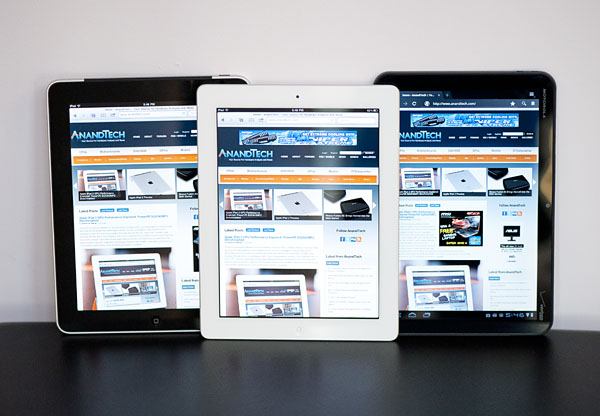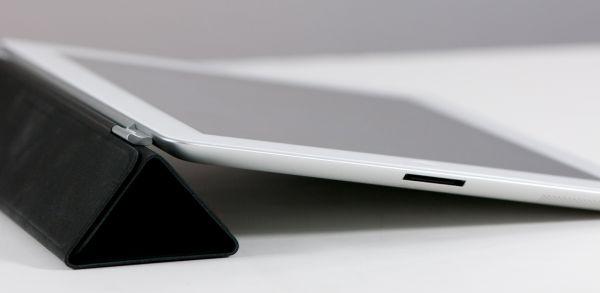Tablets: How Would You Solve the Input Problem?
by Anand Lal Shimpi on March 29, 2011 2:22 PM EST- Posted in
- Tablets
- Apple
- iPad 2
- Ask AnandTech
- Mobile
In our iPad 2 review I mentioned that despite really liking the device, I never really could integrate the original iPad into my daily life in a meaningful way. I always ended up traveling with the iPad and a notebook or while around town I just kept a smartphone on me. That limited my iPad use to pretty much lounging around at the house, and even then I found myself turning to the laptop more often than not.
With the Xoom and iPad 2 I've been giving the tablet usage model another try. I've kept my usage mostly consumption focused. Browsing the web and reading emails. I really do prefer using a tablet for both of these things. I do wish the iPad 2 was faster when selecting lots of emails but the improvement over the original iPad is still considerable.
My holdup is this: while I love reading on the iPad 2, I have troubles contributing using it. Writing lengthy email responses or even posting comments on AT is just slower on the iPad than on a notebook. The solution can't be to just walk over to a laptop when I want to respond and just use the iPad when I'm reading - that seems horrible inefficient.
I could use a Bluetooth keyboard but that's also rather clunky. I feel like there has to be a better solution going forward, particularly as the tablet market grows. Is it voice? Or some sort of an integrated kickstand with more flexibility than what you get with the smart cover?
I feel like smartphones get a pass because it's easy to type on them regardless of where you're sitting. Tablets on the other hand need to be propped up against something and as a result are harder to type on in certain situations. They work fine on a desk but if I'm at a desk I'd rather use a notebook. What about when laying back on a couch?
I'm curious what you all think about this. Am I alone in finding tablet ergonomics a barrier? If not, what do you believe is the best solution for tablets going forward. I want to read and respond on a tablet as quickly as I can on a notebook. What needs to be built? Post your comments here and I'm sure we can get many of the tablet manufacturers to pay attention. I don't think they have stumbled across the best solution for this problem either, so what you say here might go a long way in making tablets better for everyone.












247 Comments
View All Comments
ABR - Wednesday, March 30, 2011 - link
It seems that most of the people confused about why the tablets are selling so well, including Anand (whom I have the greatest respect for), are missing a really crucial point. It's not mobile browsing, office, or email, but the apps!The touchscreen interface IS a different paradigm from WiMP (Windows, Mouse, and Pointer). Apple understood this and launched the iPhone based around a new UI framework built from the ground up to produce apps designed around that UI. Folks keep talking about email, web browsers, and things like that -- but these are applications built around WiMP. OK, you see some minor advantages here and there, it's nice for consumption when a laptop would be too heavy, etc. etc., but these are NOT what it's all about. These are NOT why the iPhone took off, and they are NOT why tablets suddenly started selling with the iPad. They are taking off because people are designing apps built around the touchscreen, to operate in ways that aren't possible or enjoyable in WiMP.
So I would humbly suggest to any reviewers to try to survey some of the specialized apps out there, relating to your own hobbies, interests, and habits, rather than basing assessments on how the browser is, or what it's like to type text.
And by the way, note that NONE of this has anything to do with Apple. They started it, just like they did with WiMP, but Android looks more and more like it will prove to be the Windows of the mobile age -- not quite as slick, but commoditized and highly available, taking the lion's share in the end.
R3MF - Wednesday, March 30, 2011 - link
"Tablets: How Would You Solve the Input Problem?"There is no problem to solve, we simply have to accept that there is a difference between productivity computing and casual computing, and that for the former a 12" 1366x768 screen tied to a keyboard and a non-Atom CPU is the minimum possible configuration.
This chap put it quite well when talking about the failure of the 'classic' netbook, same thing applies:
http://jedibeeftrix.wordpress.com/2010/08/28/redef...
wittgenfrog - Wednesday, March 30, 2011 - link
I have used a Windows tablet for several years. These are a different kettle of poisson to iPads and the current 'consumer' tablets, but nonetheless they share the difficulty of inputting data.The handwriting recognition in W7 is pretty good, and if, like me, you are an older person, used to hand writing, this is a viable form of input. However many people today are not very comfortable with hand writing, so this won't really work for them.
The key technology is, I'm sure, Speech Recognition. All those Star trek dreams of chatting with our computers are gradually coming true. As our gadgets become more self and mutually aware and integrate and interact more seamlessly I fully expect Speech to be developed further, and play a key role.
For instance whilst using your table you ask "who's so and so?" the Tablet does the Speech Recog, and hands the query off to your PC or to the Interweb... Expand this to Home TV, Audio etc and its definitely the future...
7Enigma - Wednesday, March 30, 2011 - link
Here's my slightly crazy thought when approaching the catch-22 of a tablet:Put the keyboard on the back of the tablet. We all have to learn to do something new and by attempting to keep the same QWERTY-style but broken up similar to the Microsoft Natural keyboard the actual learning curve should be small. The left hand would have the same keyboard layout as what your left hand would have on a normal keyboard just rotated 90 degrees to the left, while the right hand would have the same rotated to the right. Think like an accordion.
The only barrier to this I see is really flexibility. My personal belief is that a keyboard needs to be real and not virtual for actual productivity so tactile keys like a blackberry would be required. This means you would have to decide for the customer to either put the keys on the longer sides (portrait mode), or on the shorter sides (landscape mode), as it is unlikely to have both and I don't know which would be preferable.
This could be one of those revolutionary design changes that takes time to get off the ground but becomes the norm for tablets in the future (think of the mouse replacing the trackball).
Royalties please.... :)
7Enigma - Wednesday, March 30, 2011 - link
And had I actually read the comments (comon there's 15 pages! :)) I would have seen a lot of other people had the same thought. Oh well.rs2 - Wednesday, March 30, 2011 - link
The solution to this problem today is the same as it was when tablets were initially tried a decade ago. Stop using tables, and get a laptop instead. Really, just because some popular tech guy decides to declare tablets "the next big thing" doesn't mean you have to listen.If the tablet form-factor allowed a device to be as capable as a laptop or netbook, then it would have been done years ago. It's silly to revisit the same idea and expect a different result just because the marketing hype claims it to be so.
JonBendtsen - Wednesday, March 30, 2011 - link
What if part of the tablet input problem could be our western styled alphabet/language? Maybe the asian style sign language would work better?Mau1_wurf_1977 - Wednesday, March 30, 2011 - link
I can understand where Anand is coming from. You are in "browsing mode" but then you get an email or see a forum topic and you really want to answer the email or answer the forum topic.Information flows 24/7 these days, and so do peoples information needs.
Now I thought a while about how you might be able to solve this. I don't think the ipad will ever be used for creating complex documents, so I'm calling the activity editing / answering rather than creating documents.
Because if you want to create a decent presentation or a lengthy article, you would use your notebook. However there are these momemnts where you just had a though, and would like to make some quick changes to an existing document, a blog, answer an email and so on.
So to me it seems we have 2 activities. Viewing and browsing and editing / answering.
So this is my suggestion:
At the front the tablet stays untouched. Big screen for viewing and browsing.
However the backside will be different. It will have a real keyboard. Positioned in such a way, that you can still grip, hold the ipad. Apart from a real keyboard, there will be a very small screen. Just big enough to read text.
So when you are browsing and you get an email, you open the email, hit reply and then flip over the ipad. Now you have the keyboard and you can answer the email and see what you are typing on the small screen at the back.
So yea, that's my "vision" so to speak!
Thoughts?
Mau1_wurf_1977 - Wednesday, March 30, 2011 - link
EDIT: Regarding the screen at the back. It will feature a auto zoom / crop feature, which follows the text you are typing. So it starts off zoomed into where the cursor is and as the cursor moves, it adjust the view / zooms out.That way you will get a view that gets larger as you type more and more text...
HHCosmin - Wednesday, March 30, 2011 - link
as i look at the transformer ideea it seems better and better. you have a tablet and a net book in one. i would bump the resolution a bit and have 3g mandatory. having a detachable/optional keyboard and touchpad seems the most common way to get faster at doing some work. voice recognition would be nice but that uses quite some processign power, is not that great as people speak more languages than english, if you are in a crowded place it would not help much and so on. voice recognition may be a solution however.asus transformer is almost perfect.